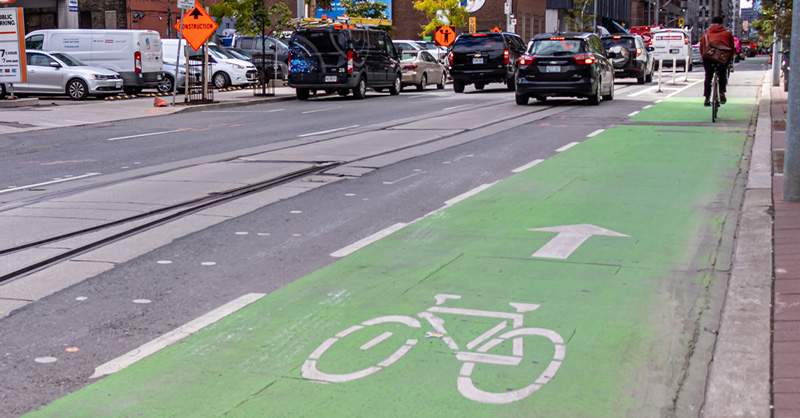On July 30, 2025, the Ontario Superior Court released a landmark decision in Cycle Toronto et al. v. Attorney General of Ontario. The court struck down the province’s plan to remove protected bike lanes on Bloor Street, Yonge Street, and University Avenue.
The ruling is a significant win for advocates of multimodal transportation and a validation of the concerns raised by the Ontario Society of Professional Engineers (OSPE). Last fall, OSPE wrote to Premier Doug Ford urging the government to rethink Bill 212, the Reducing Gridlock, Saving You Time Act. This Act would have prohibited the installation of bike lanes when motor vehicle lanes are removed and stripped municipalities of authority over local street designs.
Justice Paul Schabas found removing the lanes would increase the risk of injury and death for cyclists and other road users, engaging the right to life and security of the person under the Canadian Charter of Rights and Freedoms.
Schabas also concluded that the province’s asserted benefits of shorter travel times for drivers were unsupported by evidence, and restoring lanes for cars would only exacerbate congestion by encouraging more car use.
In its letter, OSPE warned that Bill 212 reinforced a car-centric transportation model while failing to address traffic congestion or safety. The court’s decision echoes many of these points and cites OSPE’s submission.
What the Court Said
Justice Schabas’s decision examined the evidence presented by the applicants (Cycle Toronto and two individual cyclists) and the province. Key findings include:
- Right to life and security: The court held that removing the bike lanes would expose cyclists and other road users to an increased risk of harm and death, which engages section 7 of the Charter. This marks a rare recognition of traffic infrastructure decisions as potential violations of fundamental rights.
- Evidence of increased risk: Justice Schabas found returning lanes to cars by removing protected cycling infrastructure would “create greater risk to cyclists and to other users of the roads”. He noted six cyclists had been killed on Toronto streets the previous year, underscoring the vulnerability of cyclists and the need for protected lanes.
- Congestion claims lacked evidence: The government argued that removing the lanes would reduce traffic congestion. The judge disagreed, writing that restoring lanes for cars would not reduce congestion because it would “induce more people to use cars” and any benefit would be short-lived. He described the government’s evidence as “weak anecdotal evidence” and unpersuasive.
- Cycling as a necessity: The court rejected the government’s claim that cycling is simply a recreational choice. Evidence showed that many people rely on bicycles for affordability and reliability, and some depend on cycling for their livelihood.
The province announced it will appeal the ruling, but for now, the decision preserves the bike lanes and affirms the importance of evidence-based policymaking.
OSPE’s Advocacy on Bill 212
When the province introduced Bill 212 in October 2024, OSPE responded quickly. In a public blog post and a letter to Premier Ford, OSPE raised several concerns:
- Need for multimodal solutions: OSPE advocates for a multimodal transportation strategy. In high-density areas, mass transit such as Light Rail Transit (LRT) and Bus Rapid Transit (BRT) can move large numbers of people efficiently. In low-density areas, OnDemand Transit (ODT) services can provide flexible, cost-effective transport. OSPE also highlighted the potential of Mobility as a Service (MaaS) platformsto integrate various transport modes. Transportation infrastructure should be tailored to local contexts.
- Car-centric planning: OSPE argues Bill 212 reinforcesa car-centric approach and does not address gridlock. Limiting bike lanes ignores the growing demand for sustainable and safe transportation options and undermines efforts to reduce emissions and improve public health.
- Safety first: OSPE emphasizes that bike lanes make roads safer for all users. Six cyclists were killed on Toronto streets in 2024, and limiting bike lanes undermines efforts to prevent such tragedies. Creating designated cycling lanes protects drivers, pedestrians, and cyclists.
- Empowering municipalities: OSPE advocates that municipalities require customized transportation solutions based on population density and community needs. Rather than restricting local decision-making, the province should empower municipalities and invest in diverse transit options.
The court’s decision was based on constitutional law, but Justice Schabas’s reasoning mirrored many of OSPE’s arguments. The decision explicitly referenced OSPE’s submission, recognizing the contribution of engineers to the public discourse on urban transportation.
Implications and Next Steps
The July 30 ruling does not create a constitutional right to bike lanes across Canada. However, it sets an important precedent that effective and just policymaking must be rooted in credible evidence, prioritize public safety, and reflect the realities of modern transportation.
Just as importantly, the influence of OSPE’s letter and the advocacy of engaged communities demonstrate that expert input and local voices are essential to shaping responsible, forward-thinking policy. Together, these principles form a clear mandate: decisions must be data-driven, safety-focused, and informed by those who live and work within the systems we seek to improve.
The province has signaled its intention to appeal the decision. OSPE will monitor the appeal and continue to provide evidence-based input on transportation policies.






Leave a Comment